Scientists now acknowledge cloud cover changes “control the Earth’s hydrological cycle”, “regulate the Earth’s climate”, and “dominate the melt signal” for the Greenland ice sheet via modulation of absorbed shortwave radiation. CO2 goes unmentioned as a contributing factor.
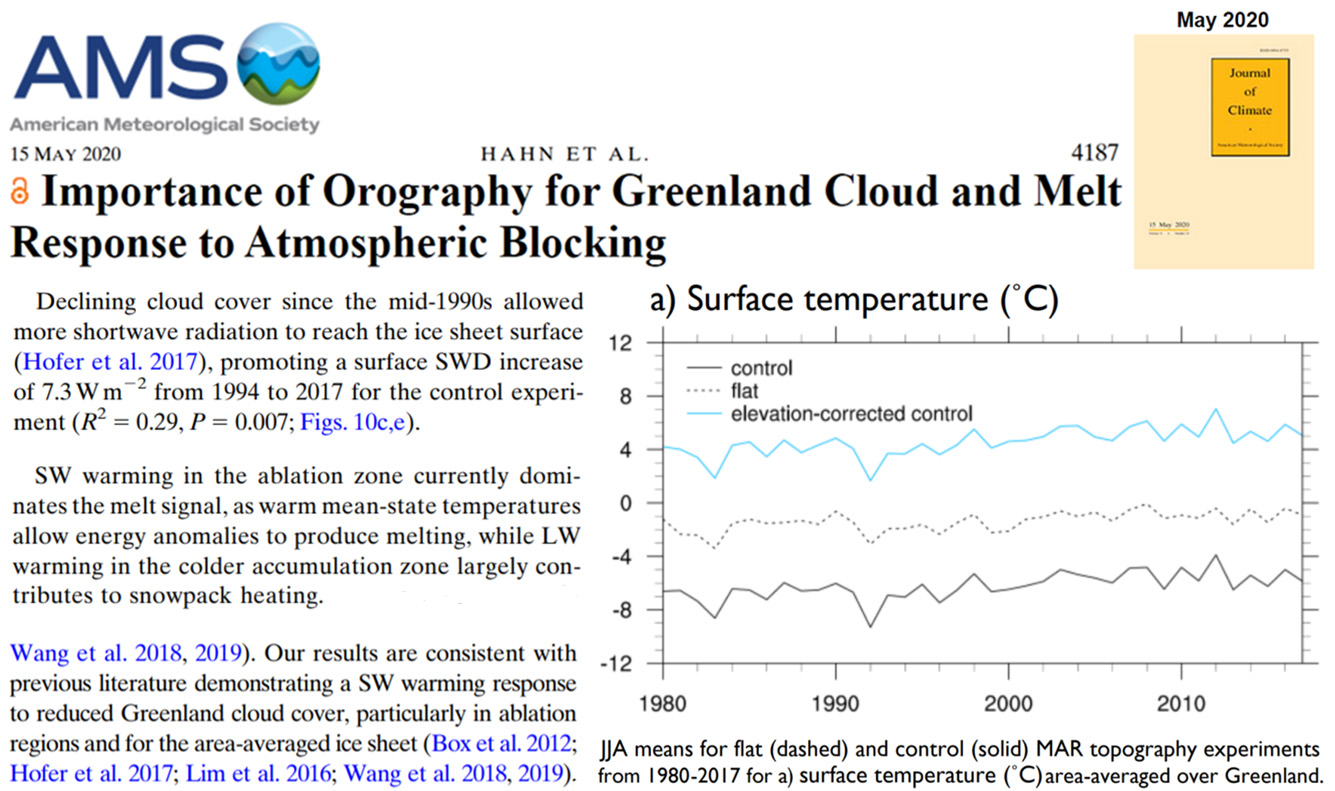
Image Source: Hahn et al., 2020
Climate modeling of factors influencing Greenland warming, surface melt have been 100% wrong
A few years ago scientists acknowledged “a major disparity in trends between models from the Coupled Model Intercomparison Project 5 (CMIP5) and observations for the last 20-30 years” (Hanna et al., 2018).
All 36 climate models simulating blocking over Greenland were wrong. None of the models were correct. The abysmal performance of the modeling relative to observations has been ongoing for the last 20 to 30 years – effectively for the entire time the CMIP5 models have been in existence.
In all other scientific fields, a one hundred percent failure rate ongoing for decades would have long ago resulted in a reassessment of modeling parameters. Climate science is apparently in a realm of its own.
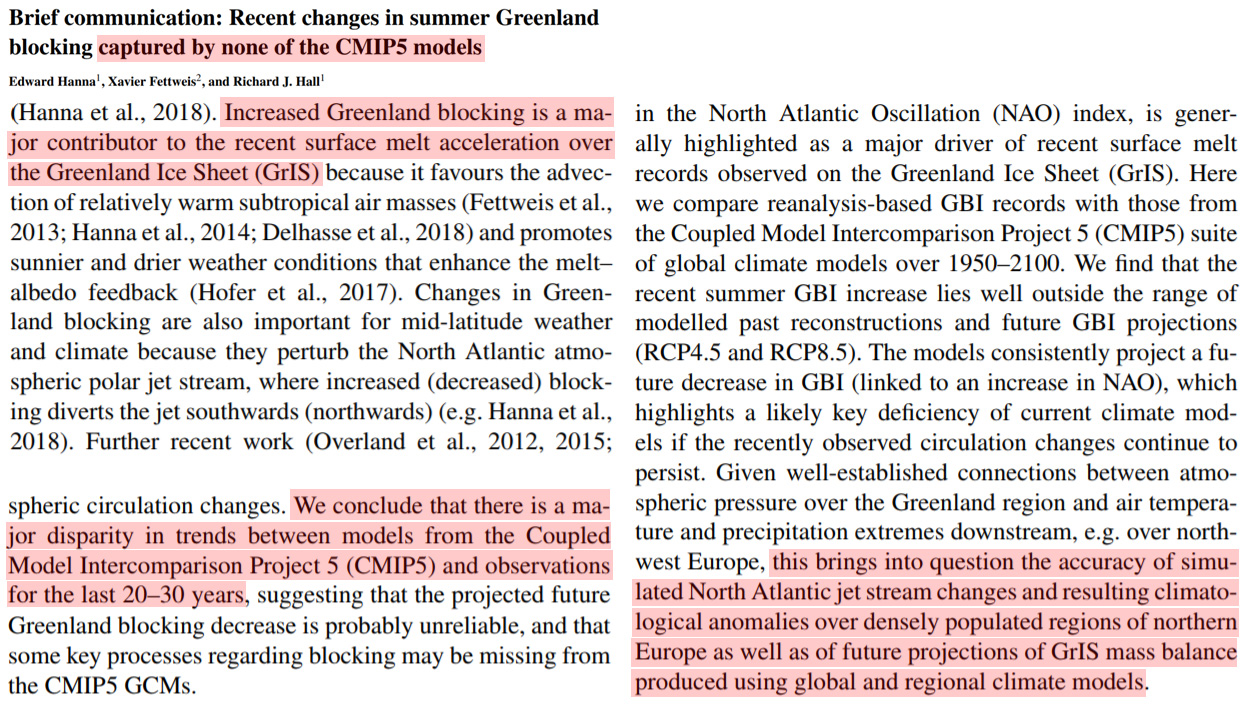
Image Source: Hanna et al., 2018
Cloud forcing dominates in the Arctic
Within a matter of hours, the radiative forcing effects from clouds can vary by ±40 W/m² in the Arctic. From one year to the next, cloud radiative effects can vary by 70 W/m² and overall cloud radiative effects can reach 360 W/m² (Ebell et al., 2020).
In contrast, the total accumulated change in net impact from CO2 forcing is only 1.82 W/m² since 1750 (Feldman et al., 2015).
Simply put, cloud forcing radiatively dominates in the Arctic. CO2 is a bit player, at most.
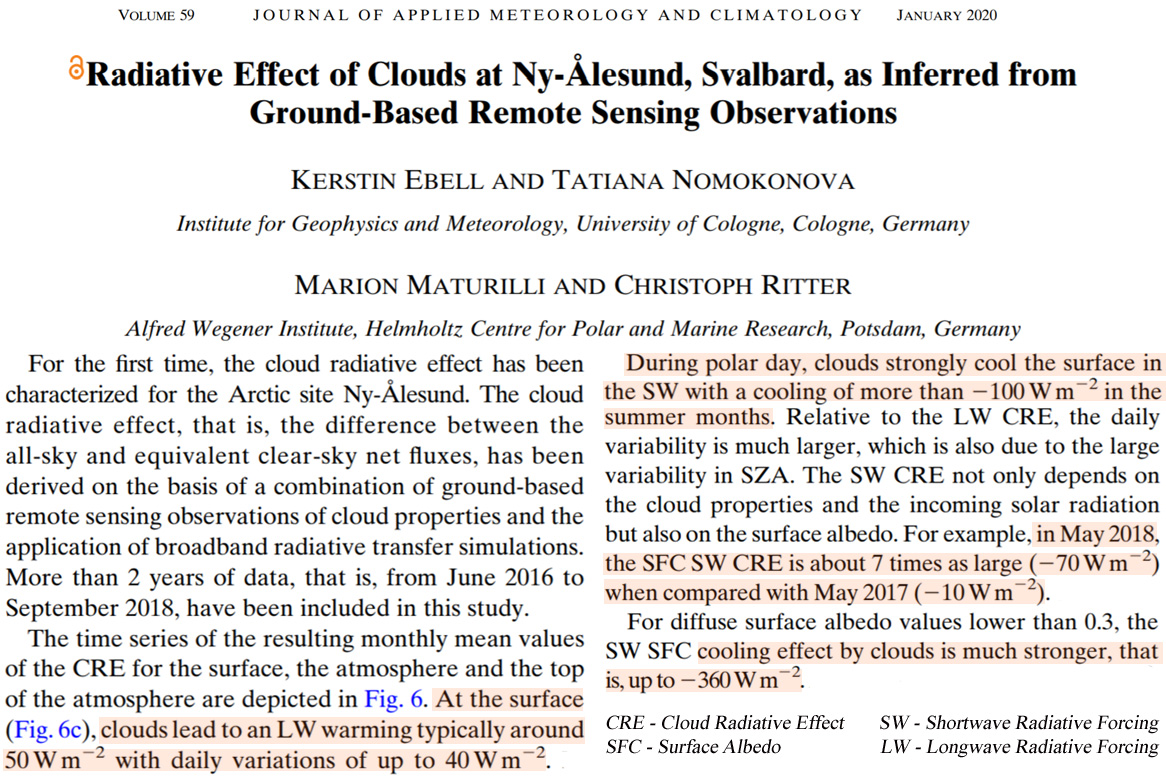
Image Source: Ebell et al., 2020
Clouds regulate Greenland’s climate…and models grossly fail to simulate this
According to a new study (Lenaerts et al., 2020), clouds “control the Earth’s hydrological cycle”, “regulate the Earth’s climate”, and drive polar ice melt.
Further, “the surface melt climate is strongly dependent on the representation of clouds and related radiation fluxes“. Models of cloud effects over Greenland are biased – or wrong – by 25-50 W/m².
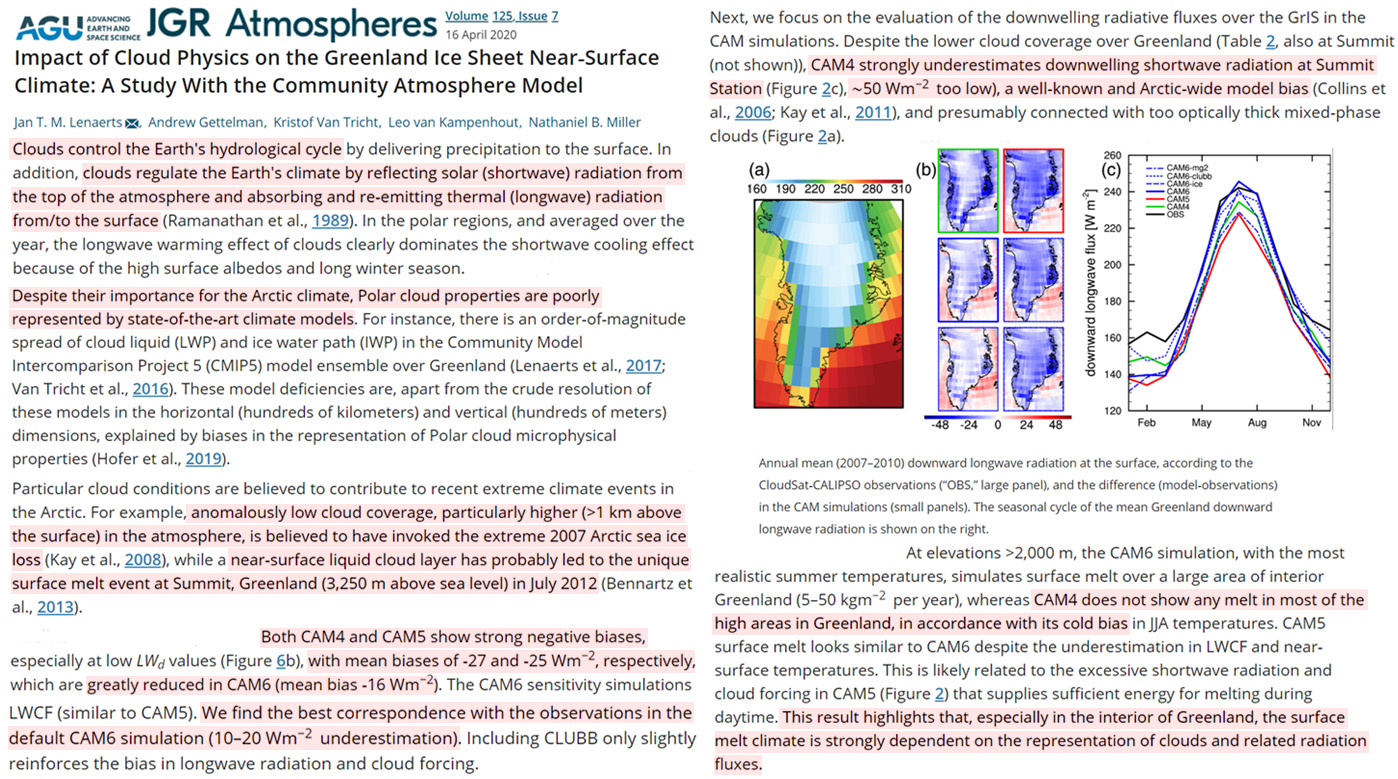
Image Source: Lenaerts et al., 2020
Cloud cover decline from 1994-2017 “dominates” the warming and ice melt trend
Another new study (Hahn et al., 2020) finds reduced cloud cover from 1994-2017 led to enhanced shortwave radiation (+7.3 W/m²) and drove the warming from the 1990s to mid-2000s. This shortwave cloud forcing trend is what “dominates” the melt signal for Greenland.
Greenland’s warming trend is shown to taper off into a pause or a slight cooling trend since ~2005. Likewise, the ice melt trend spiked in 2012 but has been flat (or declining) overall since about 2005 too.
There is thus no clear indication in the scientific literature that atmospheric CO2 concentration changes can even remotely compete with cloud radiative effects as drivers of climate trends over Greenland.
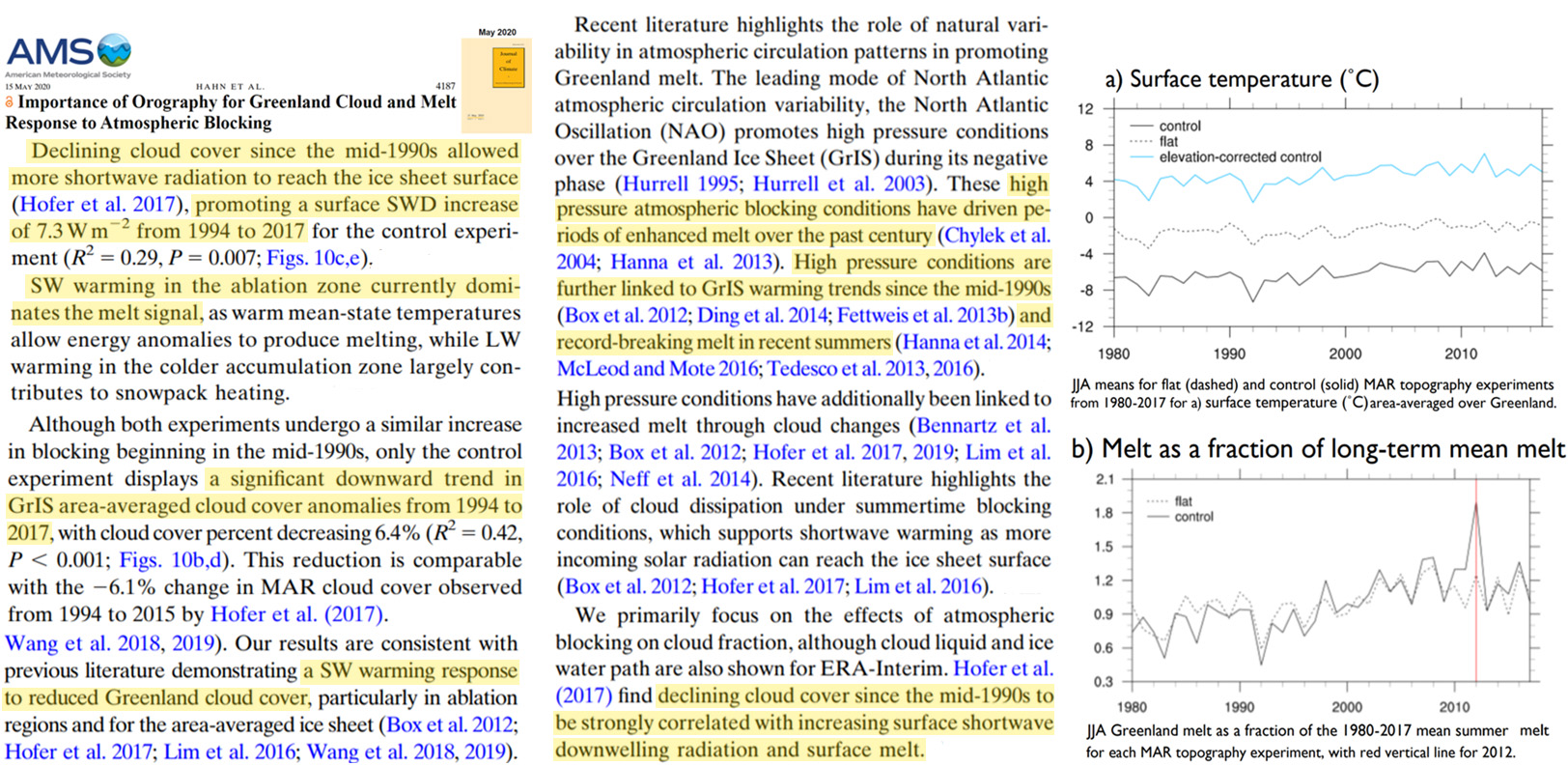





[…] über New Studies Show Cloud Cover Changes Have Driven Greenland Warming And Ice Melt Trends Since The 199… […]
[…] New Studies Show Cloud Cover Changes Have Driven Greenland Warming And Ice Melt Trends Since The 199…. Scientists now acknowledge cloud cover changes “control the Earth’s hydrological cycle”, “regulate the Earth’s climate”, and “dominate the melt signal” for the Greenland ice sheet via modulation of absorbed shortwave radiation. CO2 goes unmentioned as a contributing factor. Image Source: Hahn et al., 2020 Climate modeling of factors influencing Greenland warming, surface melt have been 100% wrong A few years ago scientists acknowledged “a major disparity in trends between models from the Coupled Model Intercomparison Project 5 (CMIP5) and observations for the last 20-30 years” (Hanna et al., 2018). […]
the formatting of this article with the large gaps btween paragraphs is causing reader problems.
I always wonder why no one mentions the non-surface hydrological flows– for example from the Gakkal Ridge– as affecting Greenland or the Arctic.
Non-saline hot water released from (underwater) Gakkel Ridge in Arctic http://www.climatechangedispatch.com/heat-from-deep-ocean-fault-punches-hole-in-arctic-ice-sheet.html
In fact, no one ever seems to mention “primary water.” Curious.
[…] Fonte: No Tricks Zone […]
But it’s CO2 that causes the changes in cloud cover!
(Can I have a research grant now, please?)
Love the comment about the 100% failure rate.
But this is climate science….facts have no place here don’t you know.
We just make up anything we want, and our friends in the media are soooo helpful. Such nice people, they never point out we are wrong, and its so nice when they misquote and attack those terrible deniers. Such awful people – they insist on facts! Who ever heard of that???
Not just Greenland.
UK’s data from Rog Tallbloke.
https://twitter.com/RogTallbloke/status/1252176970391130115/photo/1
[…] New Studies Show Cloud Cover Changes Have Driven Greenland Warming And Ice Melt Trends Since The 199… […]